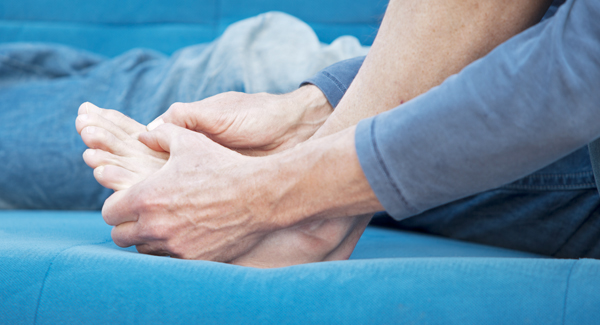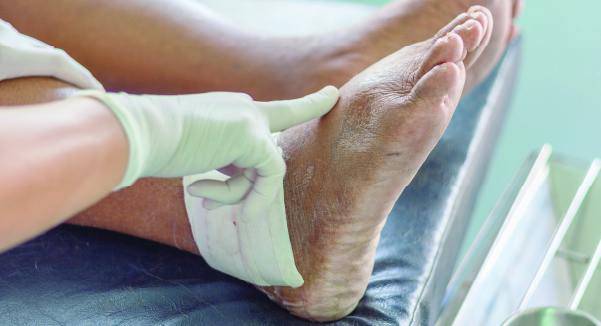Treatments for Gout
Learn what medical treatments to expect when you’ve been diagnosed with gout, and what you can do for yourself.
By Mary Anne Dunkin | June 10, 2022
Controlling gout may involve medication, physical therapy, a healthy diet and a healthy lifestyle. Work closely with your doctor and health care team to create a treatment plan that works well for you.
The goal of treatment for gout is to
- Relieve pain and inflammation of acute attacks
- Reduce uric acid level to 6 milligrams per deciliter (6 mg/dL) or lower to reduce further attacks
- Prevent joint damage
- Preserve function and help you continue normal daily activities
Medications
Medications are an essential part of treatment for many people with gout. Medications for gout have two purposes: to relieve pain and inflammation of acute attacks and to control uric acid levels to prevent further attacks. Your treatment plan will likely include some of the following:
For Relief of Acute Attacks
- NSAIDs. In low doses, nonsteroidal anti-inflammatory drugs (NSAIDs) can be effective at relieving pain. At higher prescription doses they can also help control inflammation. It’s important to note that if have kidney disease along with gout, you should not take NSAIDs.
- Analgesics. For less severe gout pain, over-the-counter acetaminophen (Tylenol) may be sufficient. For severe pain, speak with your doctor about other pain relievers.
- Corticosteroids. Similar to the cortisone your body makes naturally, corticosteroid medications are potent anti-inflammatories. Your doctor may prescribe oral or injected corticosteroids to quickly reduce inflammation during a gout attack.
- Colchicine. This oral anti-inflammatory is commonly prescribed to both treat acute attacks and prevent further attacks.
For Lowering Uric Acid
The following drugs reduce levels of uric acid by decreasing its production or increasing its elimination through the kidneys.
- Allopurinol (Zyloprim). A member of a drug class called xanthine oxidase inhibitors (XOIs), this medication, taken orally each day, reduces the body’s production of uric acid.
- Febuxostat (Uloric). If you are unable to take allopurinol, your doctor may prescribe febuxostat, another XOI. (Febuxostat carries a higher risk of heart disease than allopurinol.) Taken by mouth daily, febuxostat reduces uric acid production.
- Pegloticase (Krystexxa). One of the newer treatments for gout, pegloticase is reserved for those whose gout hasn’t responded to other treatments. This biologic agent, administered every two weeks by intravenous (IV) infusion, converts uric acid into allantoin, a chemical compound which is easily eliminated by the body.
- Anakinra (Kineret) and canakinumab (Ilaris). Anakinra and canakinumab are members of a class of biologic drugs called interleukin-1 (IL-1) inhibitors. Reserved for patients for whom other medications are not effective or well tolerated, they are given by injection.
Keep a Healthy Lifestyle
Adopting healthy lifestyle habits can help you improve your overall health, live better with gout, maintain your daily activities and potentially reduce your risk of gout attacks and joint damage.
Eat Right
Adopting a healthy diet is the most important lifestyle factor in managing gout. In fact, some people can manage gout with dietary changes alone.
Uric acid is produced when your body breaks down purine, a chemical that occurs naturally in your body as well as in certain foods. Avoiding foods high in purines — including red and organ meats, some seafoods and alcohol — may help you reduce uric acid levels in your blood and lower your risk of gout attacks.
In addition to consuming a healthy diet low in fats and rich in fruits and vegetables, you should avoid or at least limit foods that can cause uric acid levels to rise.
What to eat/drink:
- Fruits, vegetables and whole grains
- Non-meat proteins such as low-fat dairy products, beans and lentils
- Lean meats and poultry
- Water for hydration
- Coffee
- Cherries or cherry juice
What to avoid (or consume in moderation):
- Foods and drinks containing high-fructose corn syrup
- Fatty cuts of meat and high-fat dairy products
- Organ meats, which have high levels of purine
- Shellfish, anchovies and sardines, all of which are high in purines
- Alcoholic beverages, including beer — especially during a gout attack
Maintain a Healthy Weight
Losing weight if you are obese or overweight may reduce uric acid levels and your risk of gout attacks. Less weight also means less stress on painful joints.
Stay Active
Regular physical activity, particularly between gout attacks, is an important part of your gout treatment plan. Research suggests that regular low- to moderate-intensity exercise can reduce uric acid levels. Regular activity can also play a role in a weight loss plan and can help keep joints mobile. However, you should speak with your doctor before exercising during an acute attack.
Practice Pain-Relief Techniques
A gout attack is intensely painful. In addition to taking pain-relieving medications as your doctor prescribes, you can take measures on your own to manage the pain.
- Apply ice. A commercial ice pack, bag of frozen vegetables or crushed ice wrapped in a dish cloth soothe painful joints and reduce pain and inflammation.
- Use self-help devices. If painful joints make it difficult to do your daily tasks, check out assistive devices, like a walking cane, to make them easier.
- Take the pressure off. If your big toe — a common site of gout — is affected, go without a shoe on that foot, cut a hole in your sock to relieve the pressure on your big toe and use a box or device to lift your bed sheet off your toes at night.
- Elevate your foot. For a swollen foot, sit or lie down and prop your foot on pillows to keep it elevated higher than chest level.
Practice Good Self-Care
Living with a painful condition that comes and goes can be both physically and emotionally draining. It’s important to practice good self-care even when you are not in the midst of an attack.
- Learn to relax. Try self-relaxation techniques such as deep breathing, guided and visualization to relieve stress. Listen to soothing music, watch a funny movie or enjoy a hobby that you find relaxing.
- Communicate with your partner. Physical closeness with your partner can be a great pain reliever, yet pain and limited movement can make intimacy difficult. Some planning and communication with your partner can help you overcome these difficulties.
- Pace activities. Gout attacks can be physically exhausting. Pace your activities if you feel an attack starting and take time to rest through the day.
- Protect your joints. Injuries to the joints can worsen arthritis related to gout. Chose low-impact activities such as walking or swimming that aren’t overly stressful to the joints.
Surgical Options
Despite your best efforts to manage gout, you may need to consider surgery at some point to repair the damage caused by gout.
- Tophi removal. Tophi are nodules made up of uric acid crystals that can form over the structures around the joints. Tophi may become chronically inflamed, break open and become infected. Removal may be recommended to reduce the risk of complications.
- Arthroscopic uric acid crystal removal. If uric acid crystals in the joints are causing intense pain, arthroscopic removal of uric acid may be an effective way to relieve pain.
- Joint fusion. If long-term inflammation damages the smaller joints of the hands, making movement painful and difficult, a procedure called joint fusion is an option for relief. The procedure involves removing the damaged joint cartilage and using plates and screws to immobilize the bones until they fuse into single, immobile unit. While the procedure restricts motion, it is often effective at relieving pain.
- Joint replacement. A joint that is severely damaged by gout may be surgically removed and replaced with a prosthesis, improving mobility and relieving pain. The most commonly replaced joint for gout is the knee, but sometimes other smaller joints such as the elbow or ankle are replaced.
Stay in the Know. Live in the Yes.
Get involved with the arthritis community. Tell us a little about yourself and, based on your interests, you’ll receive emails packed with the latest information and resources to live your best life and connect with others.



